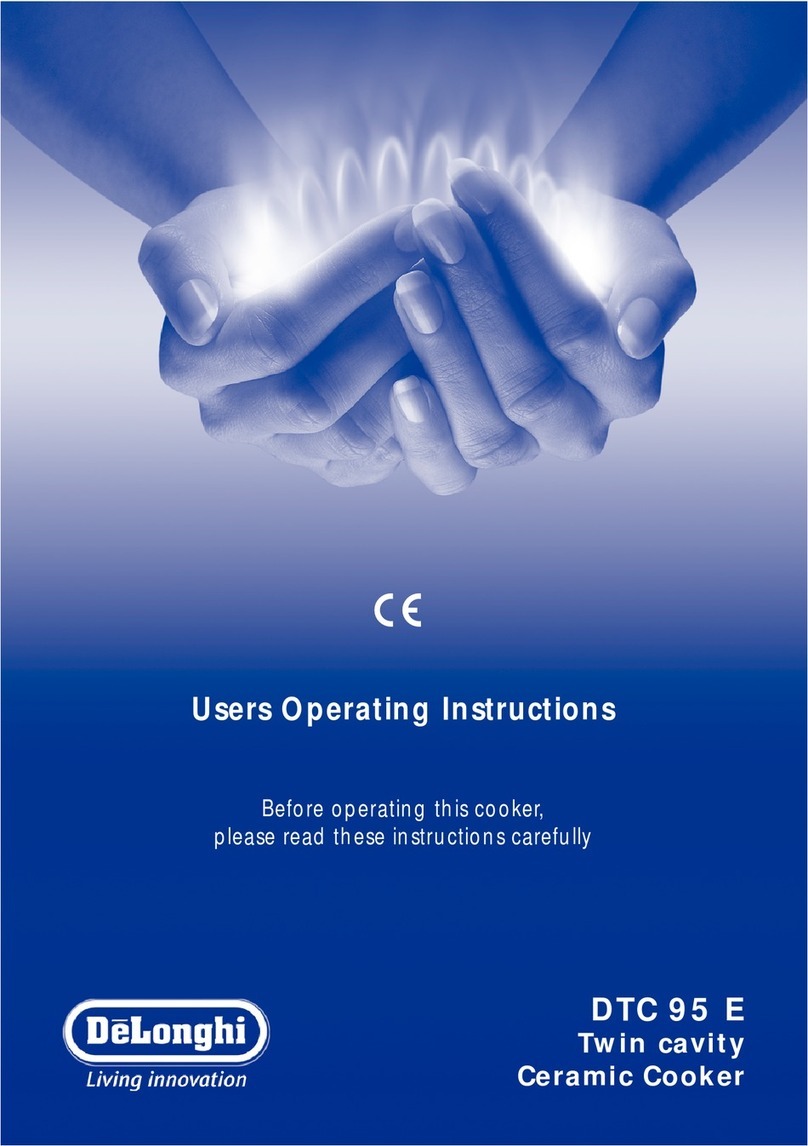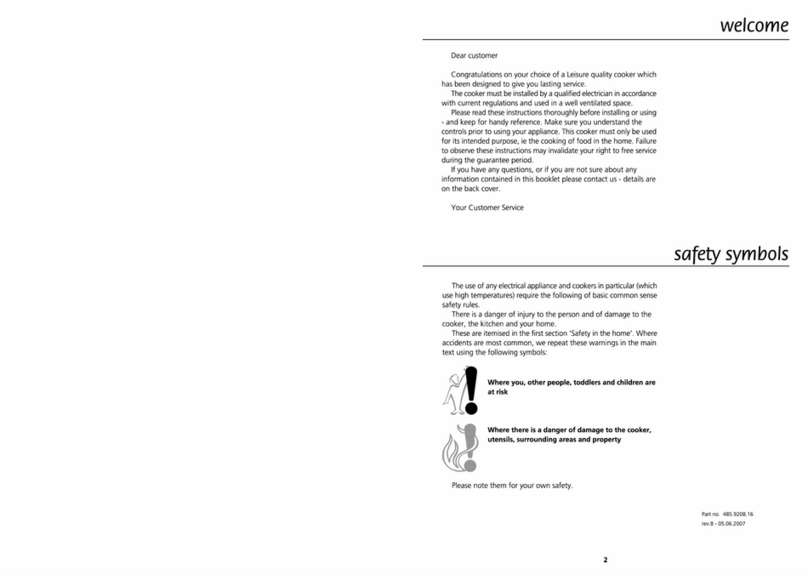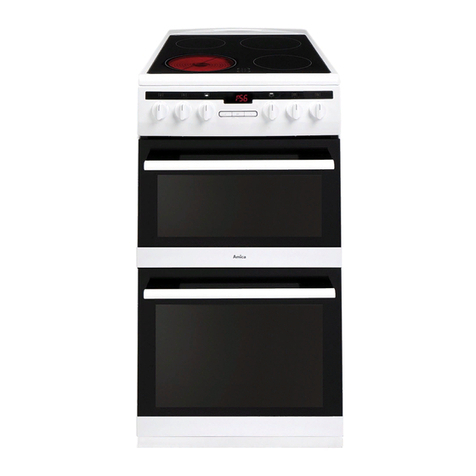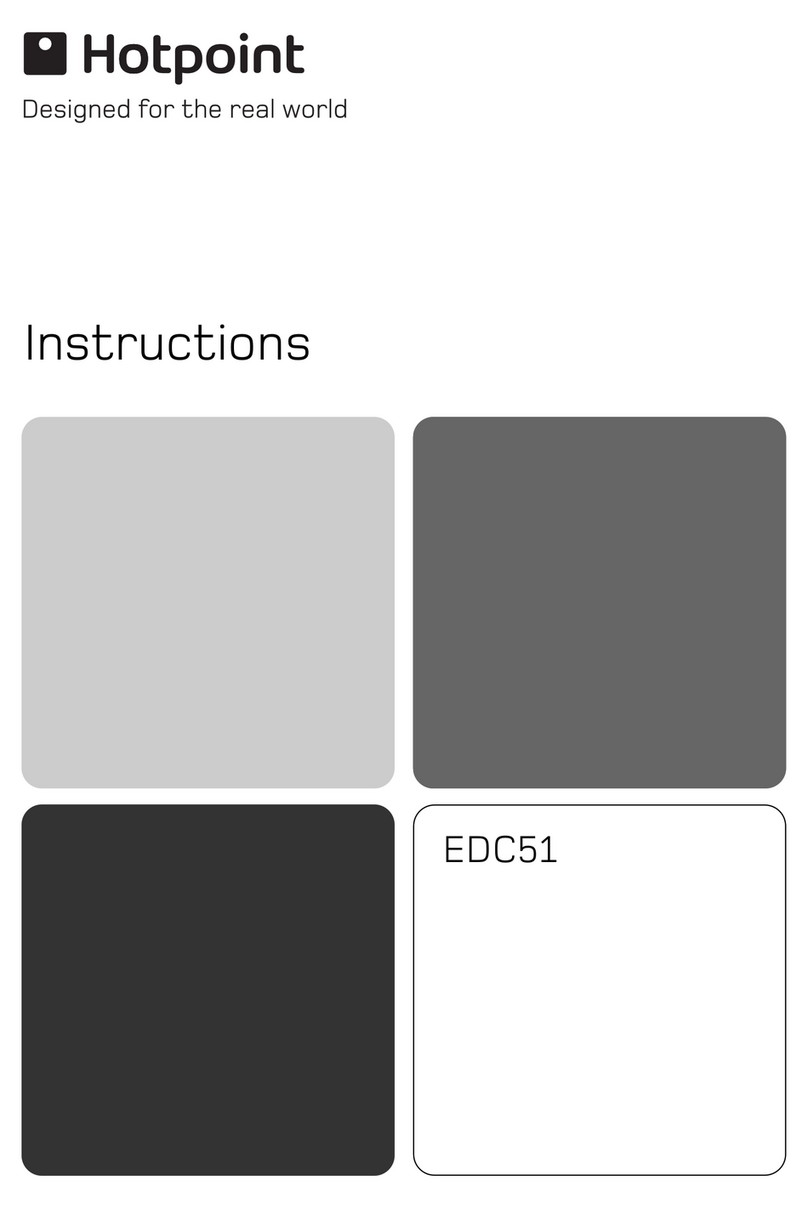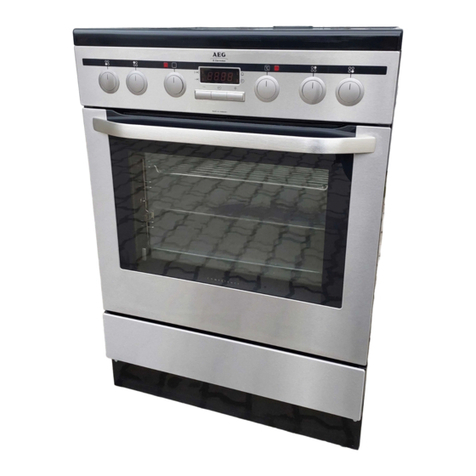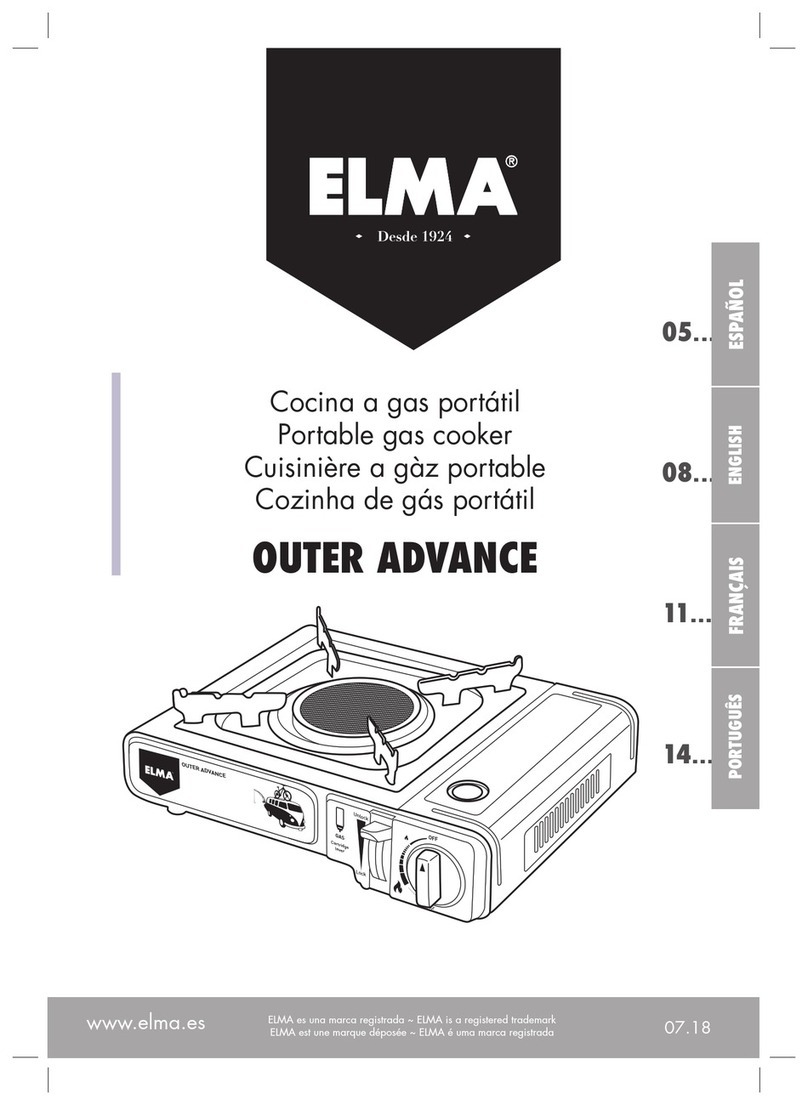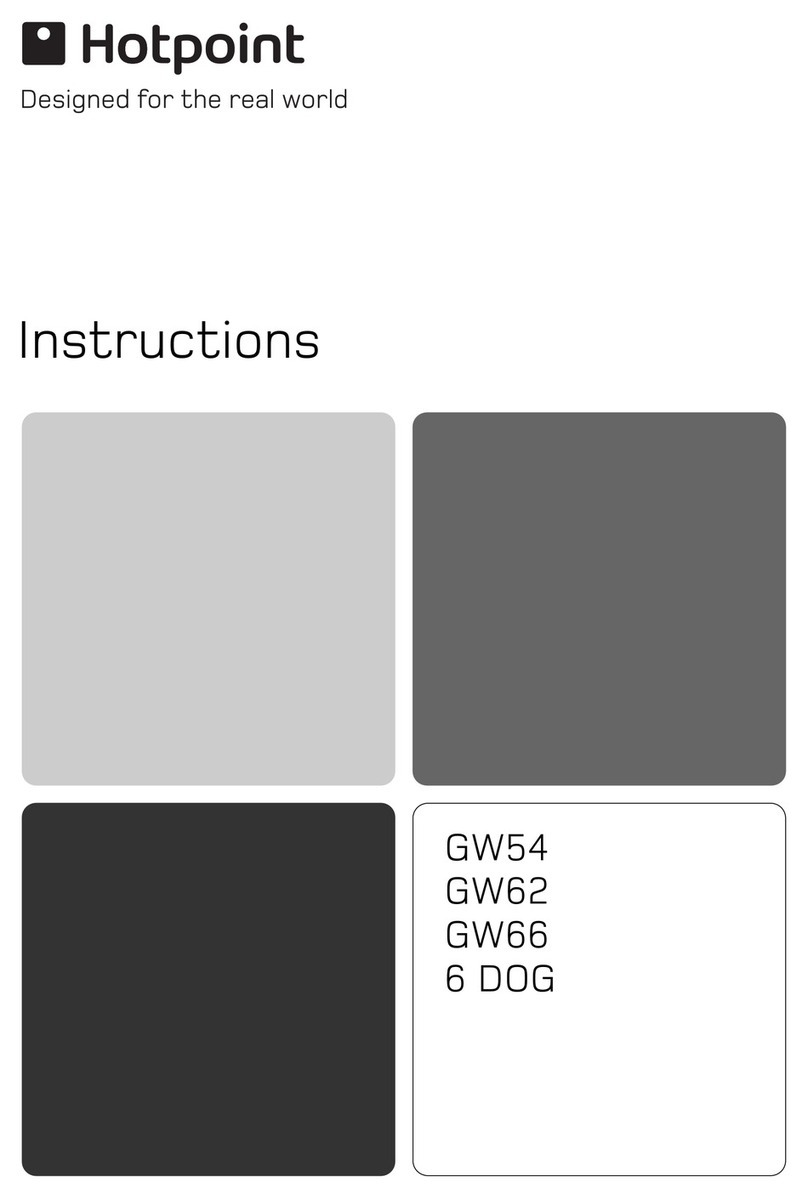Merloni CP 057 GT Operation manual

CP 857 GT
CP 859 MT.2
CP 057 GT
CP 058 MT.2
CP 059 MT.2
CP 059 MD.2
CP 058 GT (X) F
CP 059 MD.3 (X) F
Cucina mista
Istruzioni per l'uso e l'installazione
Mixed cooker
Instructions for use and installation
Cuisinière mixte
Instructions pour l'emploi et l'installation
Cocina mixta
Instrucciones para el uso y la instalación
Fogão Misto
Instruções para o uso e a instalação

1
1. This appliance has been designed for private, non-
professional domestic use in the home.
2. Readthisinstructionbookletcarefully,asitprovides
important advice regarding safe installation, use
and maintenance. Keep this booklet in a safe place
for future reference.
3. The oven accessories that may come into contact with
food are made of materials which comply with the
provisions set forth by the EEC Directive 89/109 of 21/
12/88 and the applicable national norms in force.
4. After removing the packaging, check that the appliance
is intact. If in doubt, do not use the appliance and contact
a qualified serviceman.
5. Some parts are covered with a removable scratch-proof
film. Before using the appliance, the film should be
removed and the underlying part cleaned with a cloth
and a non-abrasive household cleaning product. When
switching on the appliance for the first time, we
recommend you heat the oven at the maximum
temperature setting for about 30 minutes with nothing
in it to eliminate any residue from manufacture.
6. All installation and adjustment operations should be
carried out by a qualified serviceman in accordance with
the applicable norms in force. Specific instructions are
provided in the section intended for the installer.
7. Before connecting the appliance, make sure that the
data on the rating plate (situated underneath the
appliance and on the last page of this instruction booklet)
correspond to the mains electricity and gas supplies.
8. During operation, the oven glass door and adjacent parts
of the appliance become hot. Make sure, therefore, that
children do not touch the appliance. For greater safety,
an additional child-safety device is available from our
Head Office and our Authorised Service Centres (see
enclosed list). When ordering this, please give the code:
BAB - followed by the appliance model. The model is
stamped on the rating plate affixed to the rear of the
appliance and at the back of this booklet.
9. Check that the capacity of the electrical system and the
power outlets are suitable for the maximum power of
WARNINGS
THESE INSTRUCTIONSARE ONLY VALID FOR THE COUNTRIES OF DESTINATION WHOSE SYMBOLS ARE SHOWN
IN THE BOOKLET AND ON THE APPLIANCE RATING PLATE.
Congratulations for choosing an Ariston appliance, which you will find is dependable and easy to use. We recommend you
read though this booklet for the best performance and to extend the life of your appliance. Thank you.
the appliance, indicated on the rating plate. If in doubt,
consult a qualified technical engineer.
10. Check the condition of the gas connection pipe regularly
and have it replaced by a qualified technical engineer as
soon as it shows any signs of wear or anomaly.
11. Under no circumstances should the user replace the
power supply cable or the gas connection pipe of this
appliance. In the event of damage or the necessity for
replacement, contact an authorised service centre only.
12. Do not leave the appliance plugged in if it is not in use.
Switch off the main switch and turn off the gas supply
when the appliance is not in use.
13. The burners and the cast-iron pan supports remain hot
for a long time after use. Do not touch them.
14. To avoid accidental spills, do not use cookware with
uneven or warped bottoms on the burners.
15. Never use flammable liquids such as alcohol or gasoline,
etc. near the appliance when it is in use.
16. If the cooker is placed on a pedestal, take the necessary
precautions to prevent the same from sliding off the
pedestal itself.
17. If the appliance is fitted with a lid, any boiled over liquid
should be removed from the hob before shutting it.
18. Where present, do not shut the lid if the hob is still hot.
19. do not use steam cleaners to clean your oven

2
COOKER DESCRIPTION
E
F
fig.1
AAuxiliary gas burner
BSemi-rapid gas burner
CRapid gas burner
DTriple ring gas burner
DC-DR gas burner
EIgnitor for Gas Burners
FSafety Device - Activates if the flame accidentally goes
out (spills, drafts, etc.), interrupting the supply of gas to
the burner.
GElectric oven selector knob (cooking mode selection)
HElectric oven thermostat knob (temperature selec-
tion)
MControl knobs for gas burners
RSupport grid for cookware
PTimer
SElectric heating element indicator light
TMinute minder
UEnd of cooking programmer
VGas oven thermostat knob (gas oven mode selector
with temperature adjustment and electric grill)
ZGas oven light button

3
INSTRUCTIONS FOR USE
Gas burners
On the control panel, the following symbols are indicated
around each knob "M" or on the knob itself: Cock
Off
High flame
Low flame
Moreover, the symbols near the knobs indicate the
position of the relative burner on the hob.
The burners are fitted with a safety thermocouple device
against gas leaks. This device interrupts the gas supply
should the burner flame go out during operation.
To light one of the burners, proceed as follows:
• turn the relative knob anti-clockwise until the pointer is on
the high-flame symbol;
• press the knob down fully to actuate the automatic gas
ignition;
• keep the knob pressed down for about 6 seconds with the
flame lit to allow the safety thermocouple to heat;
• release the knob, checking that the flame is stable. If it is
not, repeat the operation.
For minimum power, turn the knob towards the low flame
symbol. Intermediate positions are possible by simply setting
the knob anywhere between the high and the low flame
symbol.
Important:
• Do not actuate the automatic ignition device for more than
15 consecutive seconds.
• Difficulty in ignition is sometimes due to air inside the gas
duct.
• If a burner flame accidentally goes out, the gas continues
to exit for a few moments before the safety device is
actuated. Turn the control knob to the off position and do
not attempt ignition again for at least 1 minute, thereby
letting the gas disperse, which could otherwise be a danger.
• When the appliance is not in operation, check that the
knobs are set to the off position " ". The main gas supply
cut-off cock should also be turned off.
Practical advice on using the burners
To obtain maximum efficiency from the burners, we
recommend you only use pans with a diameter suitable for
the burner being used, so that the flame does not extend
beyond the pan base (see the following table).
When a liquid starts boiling, we recommend you turn the
flame down just enough to keep the liquid simmering.
fig.2
The "dual independent flame" burner
This gas burner consists of two concentric burner rings which
can be actuated together or independently. When the two rings
are used together at the highest setting, the burner reduces
the length of cooking time with respect to traditional burners.
The dual ring also distributes heat more evenly on the bottom
of cookware, especially when both burner rings are used at
the lowest setting. Cookware of any size can be used. If small
pots or pans are used, only turn the inner burner on. Each
burner ring has its own control knob:
the knob indicated by symbol controls the inner ring;
the knob indicated by symbol controls the outer ring;
To turn on one of the two rings, press the relative knob in all
the way and turn it anti-clockwise to the maximum setting
The burner is fitted with an electronic ignitor that is actuated
automatically when the knob is pressed.
Since the burner is fitted with a safety device "F", the
knob should be pressed for approximately 6 seconds for the
device keeping the flame lit automatically to heat up.
To turn the burner off, turn the knob clockwise until it stops
(corresponding again with the “ ” symbol).
For the best performance of your burners, keep the follow-
ing in mind: All types of pans can be used on the burners.
The important thing is that the bottom should be completely
even.
The hob is fitted with reducing pan stands
(fig. 2), which should only be used on
auxiliary burner "A" and on the DC-DR
(inner) "I".
renruB)mc(retemaiDnaPø
yrailixuA.A 41–6
dipar-imeS.B 02–51
dipaR.C 62–12
gnirelpirT.D 62-42
)renni(RD-CDgnirelbuoD.I 41-01
)retuo(RD-CDgnirelbuoD.I 82-42

4
WARNING: when the grill is in operation, the
surrounding parts can become very hot. Please keep
children away from the cooker.
Oven light
To turn the gas oven light on, press button "Z" with the symbol
.
Minute minder "T"
This is a buzzer timer situated on the control panel and is
suitable for timing up to a max. of 60 minutes.
Turn the knob with the symbol until the pointer is aligned
with the required time.
When the set time has elapsed, a buzzer sounds (it does
not turn the oven off).
It is advisable to turn the knob to 60 and then back to the
time required, even if this less than 60 minutes.
Spit - Rotisserie
This accessory is to be used exclusively when grilling food.
Proceed as follows: insert the meat to be cooked along the
length of the spit rod, securing it with the special adjustable
forks (fig.5a).
Introduce the supports “A” and “B” (fig.5b) into the holes in
the drip tray “E”, rest the rod groove on the seat “C” and
insert the oven rack into the lowest guide of the oven; now
insert the spit rod into the relative hole, moving the groove
forward into seat “D”. Start the grill and the rotisserie by
turning the thermostat knob "G" to the position with the
symbol.
fig.5a fig.5b
fig.4
GAS OVEN-ELECTRIC GRILL
The oven burner features a thermocouple safety device.
This device automatically cuts off the gas from the burner in
a few seconds should the flame accidentally go out.
Lighting the oven burner
• open the oven door;
• press and turn the thermostat knob "V" (with the symbol
) and set it to maximum; keep it pushed.
Should there not be any electric energy, hold a lighted
match near the central hole on the oven bottom as in
fig.3;
fig.3
• keep the knob pressed in for around 10 seconds;
• release the knob, checking that the flame is stable;
• Close the oven door carefully to prevent the flame from
going out;
• wait around 10-12 minutes before placing any food to be
cooked into the oven, so as to preheat the oven suitably;
• set the temperature required for cooking by turning the
thermostat knob to the positions ranging from 1 to 8
according to the following table:
Important: if the burner flame accidentally goes out, the
gas continues to exit for a few moments before the safety
device activates.
Turn the control knob to the off position and do not attempt
ignition again for at least 1 minute, thereby letting the gas
disperse, which could otherwise be a danger.
Electric grill operation
To grill food, turn the oven control knob clockwise to position
; the indicator light "S" will also come on.
When cooking with the grill, we recommend that you
keep the oven door open and that you apply the knob
protection shield as indicated in figure 4.
sbonKnoitisoP12345678
C°041551571091012032052072

5
To provide heat only to the bottom or the top part of the
dishes, turn the selector to the position (hot below), or
(hot above).
• With the function (hot above and below + fan
assistance) traditional-type cooking (hot above and below)
is combined with fan assistancce.
• With this function (fan assisted) heat is transmitted to
the foods through pre-heated air made to circulate inside
the oven by a fan. The oven heats up very quickly so the
food to be cooked may be put into the oven as it is switched
on. Cooking is also possible simultaneously on both
shelves.
• The “fast defrosting“ function uses no heating
elements, just the oven light and the fan.
•Grill operation: a high heat output is used for grilling, so
that the surface of the food is immediately browned; this is
particularly indicated for meats which should remain tender
on the inside. To grill, turn the selector knob "G" to the
position (grill), (grill + fan).
The oven gives nine different heating element combinations;
so the most suitable type of cooking for each dish can
therefore be chosen, with convincing results.
By turning the selector knob “G” marked with the symbol
, different cooking functions are obtained, as shown in
the table on the right.
After having selected the cooking function, set the
thermostat knob "H" marked with the symbol °C to the
temperature required.
•For traditional cooking (roasts, biscuits, etc.) in
conventional mode use the function (hot above +
below).
Only put the food to be cooked into the oven when it has
reached the selected temperature and preferably use just
one shelf for cooking.
MULTI-FUNCTION OVEN
During grilling, do not set the thermostat knob to over
200 °C and keep the oven door closed (not even in the
monigrill mode).
Oven light
The oven light comes on automatically when the selector
knob is turned to any of its positions.
Indicator light "S"
It indicates that the oven is heating up. When the light goes
out, the required temperature has been reached inside the
oven.
When the light alternately comes on and goes out, it means
that the thermostat is working properly to maintain the oven
temperature constant.
Timer "U" (mod. CP 058 MT.2)
Manual operation
Turn the timer knob with symbol anti-clockwise and
set the marker to symbol (manual). Turn the oven on at
the selector knob and set the desired temperature on the
thermostat knob. To turn the oven off, turn the timer knob
back to its initial position " " .
Operation with cooking time programming
Turn the timer knob clockwise, setting the marker to the
desired cooking time (from 10 to 120 minutes). Turn the oven
on at the selector knob and set the desired temperature on
the thermostat knob. Once the countdown is over, a buzzer
will sound, and will stop doing so after 1 minute or if you
press any button whatsoever. Remember that the timer is
deactivated when cooking starts (be it immediate or
programmed).
Cooling ventilation
(CP 059 MD.2 - CP 059 MD.3 (X) F)
In order to cool down the temperature of their exterior, some
models are fitted with a cooling fan that comes on when the
programme selector knob "G" is turned. In this case, the fan
is always on and a normal flow of air can be heard exiting
between the oven door and the control panel.
(CP 059 MD.2 )
In these models, the cooling fan only comes on when the
oven is hot.
Once you have removed the food from the oven, we recom-
mend you leave the oven door ajar for a few minutes: this
will drastically reduce the duration of the cooling cycle. The
process is controlled by an additional thermostat and can
consist of one or more cycles.
lobmyS noitcnuF rewoP
0
ffO)0-
thgilnevO)1W05
stnemelegnitaehmottoB+poT)2W0532
tnemelegnitaehmottoB)3W0031
tnemelegnitaehllirginiM)4W0501
tnemelegnitaehllirG)5W0002
naf+tnemelegnitaehllirG)6W0502
naf+tnemelegnitaehmottob+poT)7W0042
naf+tnemelegnitaehdnuorraeR)8W0582
gnitsorfedtsaF)9W05

6
TIMER (ELECTRIC OVEN)
The programmer makes it possible to preset the oven and
the grill in terms of:
• delay start with a preset length of time for cooking;
• immediate start with a preset length of time for cooking;
• timer.
Button functions:
: Timer with hour and minutes;
: Length of cooking time;
: End cooking time;
: Manual change;
-: Change time (backwards);
+: Change time (forwards).
How to Reset the Digital Clock
After the appliance has been connected to the power source
or following a power outage, the clock display will begin to
blink and read: 0:00
• Press the and buttons at the same time. Then
use (within 4 seconds) the -and +buttons to set the ex-
act time.
Use the +button to move the time forwards.
Use the -button to move the time backwards.
The time can also be changed in the following two ways:
1. Repeat all of the foregoing steps.
2. Press the button, and then use the -and +buttons to
reset the time.
Manual Operation Mode for the Oven
After the time has been set, the programmer is automati-
cally set to manual mode.
Note: Press the button to return the oven to manual mode
after every "Automatic" cooking session.
Delayed Start Time with Preset Cooking Length
The length and the end cooking times must be set. Let us
suppose that the display shows 10:00.
1. Turn the oven control knob to the cooking setting and
temperature desired (example: convection oven at
200°C).
2. Press the and the use (within 4 seconds) the -and +
buttons to set the length of the cooking time. Let us sup-
pose that 30 minutes was set for the length of the cook-
ing time. In this case, the display will show:
Release the button, and within 4 seconds, the current time
will reappear with the symbol and "auto."
3. Press the button, and then use the -and +buttons to
set the end cooking time. Let us suppose that it is 13:00
4. Release the button and the display will show the current
time within 4 seconds:
When "auto" is lighted, it indicates that the length and end
cooking time have been preset to operate in automatic mode.
At this point, the oven will turn on automatically at 12:30 in
order to finish the cooking session within 30 minutes. When
the oven is on, the symbol (cooking pot) will appear on
the display for the entire length of the cooking process. The
button can be pressed at any time to display the setting
for the length of the cooking time, while the button can
be pressed to display the end cooking time.
At the end of the cooking time, an acoustic signal will
sound. Press any button it turn it off (except the - and +
buttons).
Immediate Start Time with Preset Cooking Length
When only the length of the cooking time is set (points 1
and 2 of the paragraph entitled, "Delayed Start Time with
Preset Cooking Length"), the cooking session starts imme-
diately.
Cancelling a Preset Cooking Time
Press the button, and use the -button to set the time to:
Then press the manual cooking mode button .
Timer Feature
The timer can be used to count down from a given length of
time. This feature does not control when the oven comes on
or turns off, but, rather, it only emits an acoustic signal when
the preset time has run out.
Press the button, and the display will read:
Then use the -and +buttons to set the desired time.
Release the button, and the timer will start at that second.
The display will show the current time.
At the end of the preset time, an acoustic signal will sound,
which can be turned off by pressing any button (except the -
and +buttons), and the symbol will turn off.
Changing and Cancelling Settings
• The settings can be changed at any time by pressing the
corresponding button and using the -or +button.
• When the length setting for the cooking time is cancelled,
the end cooking time setting is also cancelled, and vice
versa.
• When in automatic cooking mode, the appliance will not
accept end cooking times prior to the start cooking time
proposed by the appliance itself.

7
CLEANING AND CARE
Important: The appliance should be disconnected from
the mains supply before starting cleaning operations.
To ensure a long life cycle for the appliance, it is essential to
carry out a thorough general clean frequently, while observing
the following instructions:
Inside the oven door:
Clean the surface with a cloth moistened with hot water and
non abrasive liquid detergent, then rinse and dry thoroughly.
Inside the oven:(only on certain models)
• The inside of your oven is coated with a special self-cleaning
microporous enamel glaze which, at a normal cooking
temperature of between 200 and 300°C, oxidises and
completely eliminates all grease spots or other substances
that inevitably attack the inner walls of the oven. This way,
cleaning is kept right down to a minimum: as a matter of
fact, you just need to rub the surfaces of the oven with a
wet cloth regularly, after cooking, to remove the thin layer
of ash that may have been deposited during cooking, in
order to maintain the self-cleaning property of the oven
intact.
• After cooking where liquid has overflowed or when the dirt
has not been eliminated completely (for example when
grilling food, and the temperatures reached are not high
enough for the full self-cleaning action of the enamel to be
performed), we recommend you leave the oven on at
maximum temperature so that all grease residue and the
like are eliminated.
• If, after long-term use, you find evident grease stains
deposited on the self-cleaning oven walls, probably due to
your failing to follow the above maintenance advice, clean
the surfaces thoroughly with hot water and a soft cloth (do
not use any detergents), then rinse and dry thoroughly.
• Do not remove any dry caked-on grease using sharp
objects, as these could etch the self-cleaning coating.
• If the self-cleaning surfaces inside the oven are damaged
or worn, due to incorrect or poor maintenance or after many
years of use, you can request a kit of self-cleaning panels
to line the inside of the oven. To order these, just contact
an authorised Service Centre.
Oven exterior:
• Only clean the appliance when the oven is cold.
• The steel parts and especially the areas with the screen-
printed symbols should not be cleaned with solvents or
abrasive detergents. It is advisable to use only a damp
cloth with lukewarm water and washing up liquid.
Stainless steel may remain stained if in long-term contact
with very calcareous water or aggressive detergents
(containing phosphorus).
It is therefore always necessary to rinse and dry all surfaces
thoroughly after cleaning.
Important: cleaning operations must be made
horizontally, in the direction of the steel glazing.
• After cleaning, any treatments to polish the surfaces may
be performed: only use specific products for stainless steel.
Important: do not use abrasive powders, aggressive
detergents or acidic substances for cleaning.
Hob:
• The removable parts of the burners on the hob should be
FIG. 7
FIG. 6
washed frequently with warm water and soap, making sure
to remove any caked-on substances. Check that the gas
outlet slits are not clogged. Dry the burners carefully before
using them again.
• Clean the end part of the automatic glow plug ignitors of
the hob and gas oven frequently.
Disassembling/assembling the oven door
To make it easier to clean the inside of your oven, the oven
door can be removed, by proceeding as follows (fig. 6-7):
• Open the door completely and lift the 2 levers “B” (fig. 6);
• Now, shutting the door slightly, you can lift it out by pulling
out the hooks “A” as shown in figure 7.
To reassemble the door:
• With the door in a vertical position, insert the two hooks
“A” into the slots;
• Ensure that seat “D” is hooked perfectly onto the edge of
the slot (move the oven door backwards and forward
slightly);
• Keep the oven door open fully, unhook the 2 levers “B”
downwards and then shut the door again.
Greasing the taps
As time passes, a tap may lock or become difficult to turn. In
this case it will be necessary to clean inside and replace the
grease. This procedure must be performed by a
technician authorized by the manufacturer.
Changing the oven lightbulb
Make sure that the appliance is disconnected from the
electricity supply.
Unscrew the glass protective cover from inside the oven,
unscrew the lightbulb and replace it with an identical one
suitable for high temperatures (300°C) and with the following
characteristics:
- Voltage 230 V
- Wattage 15 W
- Type E 14.

8
Cooking times may vary according to the nature of the foods, their homogeneity and their volume. When cooking a certain
food for the first time, it is advisable to choose the lowest values in the cooking time range given in the table and then
increase them if necessary.
CONVENTIONAL oven cooking
GRILLING
FAN ASSISTED cooking
Notes:
1) Cooking times do not include oven pre-heating, except for those marked with an asterisk.
2) The indication given in the table for the guide rails is the one that should preferably be used in the event of cooking on more than one
level.
3) The indicated times refer to cooking on one shelf only; for cooking on more than one level, increase the time by 5 ÷ 10 minutes.
4) For roast beef, veal, pork and turkey, on the bone or rolled, increase the times by 20 minutes.
COOKING TIPS
The 1st guide rail is
understood as being the
lowest position.
hsidfoepyT C°erutarepmeT emitgnikooC
)setunim( hsidfoepyT C°erutarepmeT )sruoh(emitgnikooC
sekacdnaseirtsaP
eiptiurF
seugnireM
ekacegnopS
ekaclegnA
ekacariedaM
ekacetalocohC
faolteewstalF
sffuP
stiucsibyrtsapykalF
selliuefelliM
yrtsaptsurctrohS
031
031
051
061
061
071
071
002
002
002
002
07-06
04-03
03-02
05-04
05-04
04-03
05-04
02-51
02-51
02-51
02-51
taeM
)gk8-4(yekruT
)gk5-4(esooG
)gk4-2(kcuD
)gk3-½2(nopaC
)gk½1-1(feebdesiarB
bmalfogeL
)gk2(erahtsaoR
tnasaehptsaoR
)gk½1-1(nekcihC
hsiF
061
061
071
071
061
061
061
061
071
002
½4-3
½4-4
½2-½1
½2-2
½3-3
½1-1
½1-1
½1-1
½1-1
setunim52-51
hsidfoepyT mottobmorf.onliarediuG gkytitnauQ C°erutarepmeT )setunim(emiT
sekaC dluomni,ximnetaebhtiW* dluomtuohtiw,ximnetaebhtiW* esabnalf,yrtsaptrohS gnilliftewhtiwyrtsaptrohS gnillifyrdhtiwyrtsaptrohS ximdenevaellarutanhtiW* sekacllamS
3-1 4-3-1 4-3-1 3-1 4-3-1 3-1 4-3-1
1
1
5.0 5.11
1
5.0
571 571 571 571 571 571 061
06050307540503
taeM llirgehtrednustsaoR laeV feeB feebtsaorhsilgnE kroP nekcihC yartanostsaoR laeV feeB kroP nekcihC secilsyekruT kcuD seloressaC eloressacfeeB eloressaclaeV
2
2
2
2
2
3-1 3-1 3-1 3-1 3-1 3-1
1
1
1
1
1
15.1-1
1
1
15.1-1 5.1 5.1-1
1
1
081 081 022 081 002
061 061 061 081 081 081
571 571
0607050707
08090909 021 021
021 011
hsiF elos,ekah,doc,skaets,stelliF nomlas,tobrut,lerekcaM sretsyO
3-1 3.1 3-1
1
1081 081 081
035402
selabmiT hsidatsapdekaB gniddupelbategeV sélffuosyruovasdnateewS* slloryruovasdnasazziP* sehciwdnasdetsaoT
3-1 3-1 3-1 4-3-1 4-3-1
2
257.0 5.0 5.0
581 581 081 002 091
0605050351
gnitsorfeD slaemtae-ot-ydaeR taeM taeM taeM
3-1 3-1 3-1 3-1
1
5.0 57.0 1
002 050505
540507 011
hsidfoepyT emitgnikooC
)setunim( flehsfonoitisoP
)gk5.0(spohC
segassuaS
)gk1(nekcihcdellirG
)gk6.0(tipsehtnolaeV
)gk1(tipsehtnonekcihC
06
51
06
06
06
3
dr
liarediug
2
dn
liarediug
1
ts
liarediug
-
-

9
The following instructions are provided for qualified installers
so that they may accomplish installation, adjustment and
technical maintenance operations correctly and in
compliance with national current regulations and standards.
Important: the appliance should be disconnected from
the mains electricity supply before any adjustment,
maintenance, etc. is carried out. Maximum caution should
be exercised should it be necessary to keep the appliance
connected to the electricity supply.
The cookers have the following technical specifications:
Cat. II2H3+
The maximum dimensions of the appliance are given in the
figure on page 2. For trouble-free operation of appliances
installed in housing units, the minimum distances shown in
fig.8 should be observed. Adjacent surfaces and the wall at
the rear should also be able to withstand a temperature of
65 °C
Prior to installing the cooker, 99 ÷ 155 mm high supporting
feet (provided) should be fitted into the holes to be found in
the bottom of the cooker (fig.9). These feet are screw-
adjustable and whenever necessary should be used to make
sure the cooker stands level.
Positioning
This appliance may only be installed and operated in
permanently ventilated rooms in compliance with provisions
laid down by current regulations and standards. The following
requirements must be observed:
• The appliance must discharge combustion products into a
special hood, which must be connected to a chimney, flue
pipe or directly to the outside (fig.10).
• If it is impossible to fit a hood, the use of an electric fan is
permitted, either installed on a window or on an external
wall, which must be switched on at the same time as the
appliance.
INSTRUCTIONS FOR THE INSTALLER
In a chimney stack or branched flue Directly to the outside
(exclusively for cooking appliances)
Kitchen ventilation
The air flow into the room where the appliance is installed
must be equal to the quantity of air that is required for regular
combustion of the gas and for ventilating the same room.
Air must be taken in naturally through permanent apertures
made in the outside walls of the room or through single or
branching collective ventilation ducts in compliance with the
standards in force. The air must be taken directly from the
outside, from an area far from sources of pollution. The
ventilation aperture must have the following characteristics
(fig.11A):
• total free cross section of passage of at least 6 cm² for
every kW of rated heating capacity of the appliance, with
a minimum of 100 cm² (the heating capacity is indicated
on the rating plate);
• it must be made in such a way that the aperture cannot be
obstructed both on the inside and outside of the wall;
• it must be protected, e.g. with grills, wire mesh, etc. in
such a way that the above-mentioned free section is not
reduced;
• it must be situated as near to floor level as possible.
Detail A Adjacent Room to be
room ventilated
A
Examples of ventilation holes Enlarging the ventilation slot
for comburant air between window and floor
fig. 11A fig.11B
The air inflow may also be obtained from an adjoining room,
provided the latter is not a bedroom or a room where there
is a risk of fire, such as warehouses, garages, fuel stores,
etc. and is ventilated in compliance with the standards in
force. Air from the adjoining room to the one to be ventilated
may be made to pass freely through permanent apertures
with a cross section at least equal to that indicated above.
These apertures may also be obtained by increasing the
gap between the door and the floor (fig.11B). If an electric
fan is used for extracting the combustion products, the
ventilation aperture must be increased in relation to its
maximum performance. The electric fan should have a
fig.9
fig.10
fig.8
min. 50mm
min. 700mm
Class 1 Class 2 sub-class 1

10
Gas supply
• Check that the appliance is set for the type of gas available
and then connect it to the mains gas piping or the gas
cylinder in compliance with the applicable norms in force.
• This appliance is designed and set to work with the gas
indicated on the label situated on the actual hob. If the gas
supply is different from the type for which the appliance
has been set, replace the corresponding nozzles
(provided), following the instructions given in the paragraph
"Adaptation to different types of gas".
• For trouble-free operation, suitable use of energy and a
longer life cycle for the appliance, make sure that the supply
pressure complies with the values indicated in table 1
"Burner and nozzle specifications", otherwise install a
special pressure regulator on the supply pipe in compliance
with current standards and regulations.
• Connect in such a way that the appliance is subjected to
no strain whatsoever.
Either a rigid metal pipe with fittings (fig. 12-D) in compliance
with norms must be used for connecting to the nipple union
(threaded - cylindrical ½"G fitting "F") situated at the rear of
the appliance (fig. 12), or a flexible steel pipe with a
continuous wall and fittings (fig. 12-C) in compliance with
norms, which must not exceed 2000 mm in length. Check
that the connecting pipe cannot come into contact with
moving parts which could damage or crush it. For installation
with a flexible rubber pipe, apply the special hose support
for liquid gas (fig. 12-A) or natural gas (fig. 12-B). The
gasket "G" (provided) must be utilised in every type of
connection. The two ends of the pipe must be fastened with
the purpose designed pipe collars "E", in compliance with
the norms. The flexible pipe should comply with the norms,
and be specific for the type of gas used. In addition:
• it should be as short as possible, with a maximum length
of 1.5 metres;
• it should not be bent or kinked;
• it should not be in contact with the rear panel of the appli-
ance or in any case with parts which may reach a tem-
perature of 50°;
• it should not pass through holes or slits used for discharg-
ing the oven flue gases;
• it should not come into contact with pointed parts or sharp
corners;
• it should be easy to inspect along its entire length in or-
der to be able to check its condition;
• it should be replaced before the date printed on the ac-
tual pipe.
A
fig.13
fig.12
Important: A pressure regulator, in compliance with the
applicable norm in force, must be inserted when
connecting to a liquid gas supply (in a cylinder).
Upon completion of installation, check for leaks from the gas
circuit using a soapy solution (never use a flame). Make sure
that the natural gas pipe is adequate for a sufficient supply
to the appliance when all the burners are lit.
Adapting to different types of gas (instructions for the hob)
To adapt the hob to a different type of gas from the factory-
set one (indicated on the rating plate at the top of the hood
or on the packaging), the burner nozzles should be replaced
as follows:
• Remove the hob grids and slide the burners off their seats.
• Unscrew the nozzles (fig. 13), using a 7 mm socket span-
ner and replace them with nozzles for the new type of gas
(see table 1 "Burner and nozzle characteristics").
Reassemble the parts following the above procedure in
the reverse order.
• On completion of this operation, replace the old rating
sticker with one indicating the new type of gas used. This
sticker is available in the "kit of nozzle".
Replacing the independent "double flame" burner
nozzles:
• Remove the grids and slide the burners off their seats.
The burner is made up of three separate parts (see Fig.
C and Fig. D);
• Unscrew the nozzles using a 7 mm socket spanner. The
inner burner has one nozzle, while the outer one has two
(of the same size). Replace the nozzles with those for
the new type of gas (see table 1).
• Replace all the parts, following the steps described above
in the reverse order.
Fig. C Fig. D
sufficient capacity to guarantee an hourly exchange of air
equal to 3 ÷ 5 times the volume of the kitchen. Prolonged,
intensive use of the appliance may require extra ventilation,
e.g. an open window or a more efficient ventilation system by
increasing the extraction power of the electric fan if installed.
Liquid petroleum gas descends towards the floor as it is
heavier than air. Apertures in the outside walls in rooms
containing LPG cylinders should therefore be at floor level,
in order to allow any gas from leaks to be expelled. Do not
store LPG cylinders (even when empty) in basements/rooms
below ground level; it is advisable to keep only the cylinder in
use in the room and connected far from heat sources which
could raise its temperature to above 50°C.
INSTRUCTIONS FOR THE INSTALLER
fig.14

11
Electrical connection
THE APPLIANCE MUST BE EARTHED
The appliance is designed to work with alternating current
at the supply voltage and frequency indicated on the rating
plate (situated on the rear part of the appliance and on the
last page of the instruction manual). Make sure that the local
supply voltage corresponds to the voltage indicated on the
rating plate.
Connecting the supply cable to the mains electricity
supply
For models supplied without a plug, fit a standard plug,
suitable for the load indicated on the rating plate, onto the
cable and connect it to a suitable socket.
To connect directly to the mains supply, an omnipolar circuit-
breaker with a contact separation of at least 3 mm suitable
for the load and complying with current standards and
regulations must be fitted between the appliance and the
mains supply outlet.
The yellow-green earth wire must not be interrupted by the
switch.
The supply cable must be in such a position so that no part
of it can reach a temperature of 50 °C above room
temperature.
All appliances should be connected seperately.
Do not use reducers, adapters or shunts as they could cause
heating or burning.
Before connecting to the power supply, make sure that:
• the limiter valve and the domestic system can withstand
the load from the appliance (see rating plate);
• the supply system is efficiently earthed according to
standards and laws in force;
• the socket or omnipolar circuit-breaker are easily
accessible when the appliance is installed.
FAILURE TO OBSERVE THE ACCIDENT-PREVENTION
REGULATIONS RELIEVES THE MANUFACTURER OF ALL
LIABILITY.
Replacing the cable
Use a rubber cable of the type H05VV-F with a cross section
of 3 x 1.5 mm².
The yellow-green earth wire must be 2 ÷ 3 cm longer than
the other wires.
Adjusting the primary air of the burners
The primary air of the burners does not need to be adjusted.
Adjusting the low flame
• Turn the tap to the low flame position;
• Remove the knob and turn the adjusting screw, situated
to the right of the tap (fig. 14) until you obtain a regular
small flame, using a screwdriver (loosening the screw
increases the height of the flame, tightening decreases
it).
N.B.: In the case of liquid gas, the regulation screw must
be screwed in all the way.
• Having obtained the low flame setting required and with
the burner lit, abruptly change the position of the knob
several times from minimum to maximum and vice versa
and check that the flame does not go out.
• In appliances fitted with the safety device (thermocou-
ple), should the device fail to work with the burners set to
the low flame setting, increase the low flame setting of
the same on the adjusting screw.
Once the adjustment has been made, remount the seals on
the by-passes using sealing wax or similar.
Gas oven (CP 057 GT - CP 058 GT (X) F - CP 857 GT):
• Open the oven door (to reach the oven burner, remove
the floor);
• loosen the 2 screws which hold the oven burner in place,
remove the burner and replace the nozzles "N" with
suitable ones for the new type of gas according to the
table on page 12.
• re-assemble all the components, regulate the air in the
burner as well as the minimum flow of the tap.
Adjusting the low flame
• Open the door and remove the oven floor;
• put the oven knob to position maximum and light the
burner;
• close the door and wait for about 15 minutes;
• put the knob to position 1 (minimum);
• remove the actual knob and regulate the adjusting screw
situated above the thermostat spindle;
• after regulating the low flame as required, with the burner
lit, change from the high to the low flame position abruptly
for a few times and close the oven door normally, making
sure that the burner does not go out.
Adjusting the primary air
Adjust the primary air flow so that the flame is even and
does not flicker. Excess air causes the flame to rise from
the burner, while lack of air causes the gas to light inside the
burner. To adjust the flow, loosen screw “P” and move the
bushing “R”. After adjusting, secure the bushing “R” with
screw “P”.(fig. 15)
INSTRUCTIONS FOR THE INSTALLER
fig.15

12
BURNER AND NOZZLE SPECIFICATIONS
* At 15°C and 1013 mbar-dry gas
Propane G31 H.s. = 50,37 MJ/kg
Butane G30 H.s. = 49,47 MJ/kg
Methane G20 H.s. = 37,78 MJ/m3
TROUBLESHOOTING
It may occur that the appliance does not function or does
not function properly. Before calling customer services for
assistance, let's see what can be done.
First of all, check to see that there are no interruptions in
the gas and electrical supplies, and, in particular, that the
gas valves for the mains are open.
The burner does not light or the flame is not uniform
around the burner.
Check to make sure that:
• The gas holes on the burner are not clogged;
• All the removable parts that make up the burner are
mounted correctly;
• There are no draughts around the cooking surface.
The flame does not stay on
Check to make sure that:
• You press the knob all the way in;
• You keep the knob pressed in long enough to activate
the safety device.
• The gas holes are not clogged in the area corresponding
to the safety device.
The burner does not remain on when set to "Low".
Check to make sure that:
• The gas holes are not clogged.
• There are no draughts near the cooking surface.
• The minimum has been adjusted correctly (see the
section entitled, "Adjusting the low flame").
The cookware is not stable.
Check to make sure that:
• The bottom of the cookware is perfectly flat.
• The cookware is centered correctly on the burner.
If, despite all these checks, the appliance does not function
properly and the problem persists, call the nearest Merloni
Elettrodomestici Customer Service Centre, informing them
of:
- The type of problem.
- The abbreviation used to identify the model (Mod. ...) as
indicated on the warranty.
Never call on technicians not authorised by the
manufacturer, and always refuse to accept spare parts that
are not original.
1elbaT sagdiuqiLsaglarutaN
RENRUB
retemaiD
)mm(
rewoplamrehT
)*.s.H(Wk
ssap-yB
001/1
)mm(
rotcejnI
001/1
)mm(
*wolF
h/g
rotcejnI
001/1
)mm(
*wolF
h/l
.nimoN.cudeR03G13G02G
.C dipaR 00100.37.00468812412611682
.B dipar-imeS 5756.14.0034602181169751
.A yrailixuA 5500.13.0720537171759
.D gniRelpirT 03152.33.17519632232421903
.I )lanretni(RDCDemalfelbuoD 0309.04.0034456460768
.I )lanretxe(RDCDemalFelbuoD 03101.43.17507892392011093
nevOsaG00.48.05459192682241183
erusserpylppuS
lanimoN
muminiM
mumixaM
03-82
02
53
73
52
54
02
71
52
OVEN TECHNICAL SPECIFICATIONS
This appliance conforms to the following European Economic
Community directives:
- 73/23/EEC of 19/02/73 (Low Voltage) and subsequent modifi-
cations;
- 89/336/EEC of 03/05/89 (Electromagnetic Compatibility) and
subsequent modifications;
- 90/336/EEC of 29/06/90 (Gas) and subsequent modifications;
- 93/68/EEC of 22/07/93 and subsequent modifications.
ENERGY LABEL
Directive 2002/40/EC on the label of electric ovens
Norm EN 50304
Energy consumption for Natural convection:
heating mode: Convection
Declared energy consumption for Forced
convection Class:
heating mode: Fan assisted

vialeAristide Merloni, 47 - 60044 Fabriano
tel. 0732/6611 - telex 560196 - fax 0732/662954
www.Merloni.com
Mod.ARISTON
09/03 code:195037300.01 Xerox Business Services - Docutech
This manual suits for next models
7
Table of contents
Popular Cooker manuals by other brands
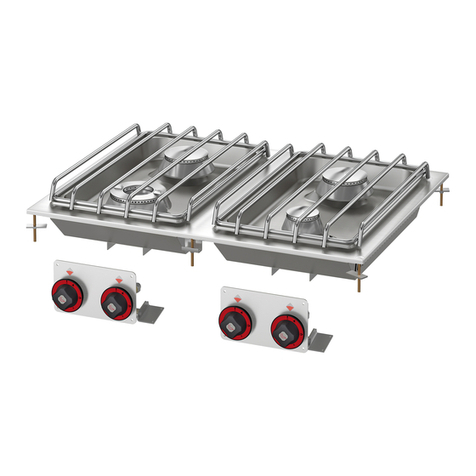
Lotus
Lotus PCD-64G Instructions for installation and use

Hotpoint
Hotpoint HDT67V9H2CX/UK manual

Rasonic
Rasonic RIC-SNG28S Operation manual

Venini
Venini VEF91GG installation instructions
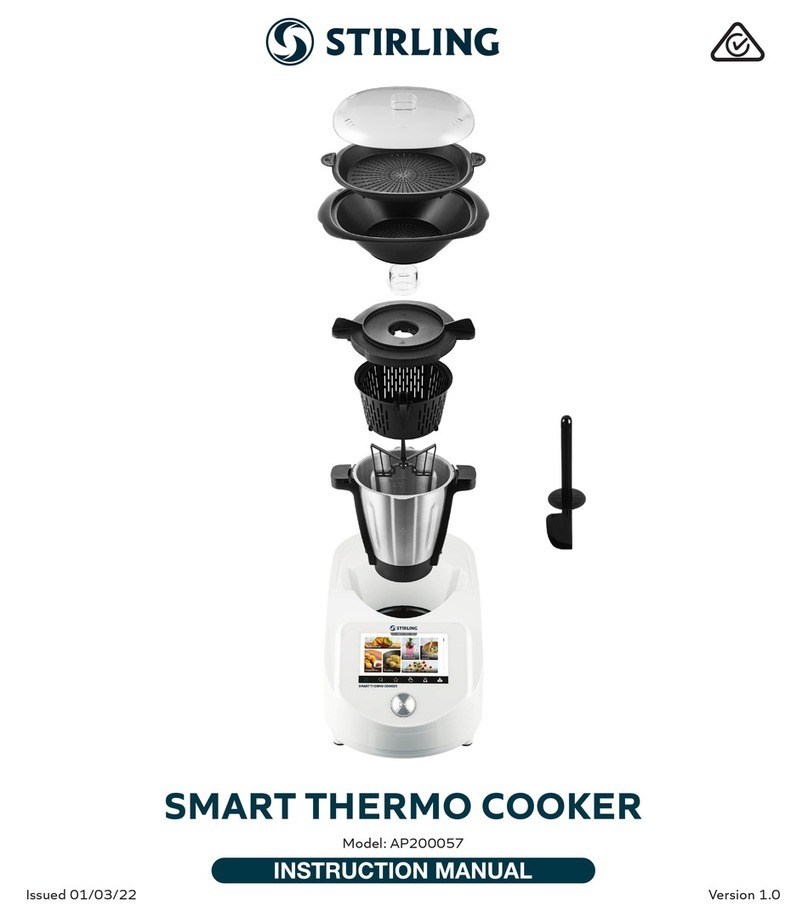
Stirling
Stirling AP200057 instruction manual
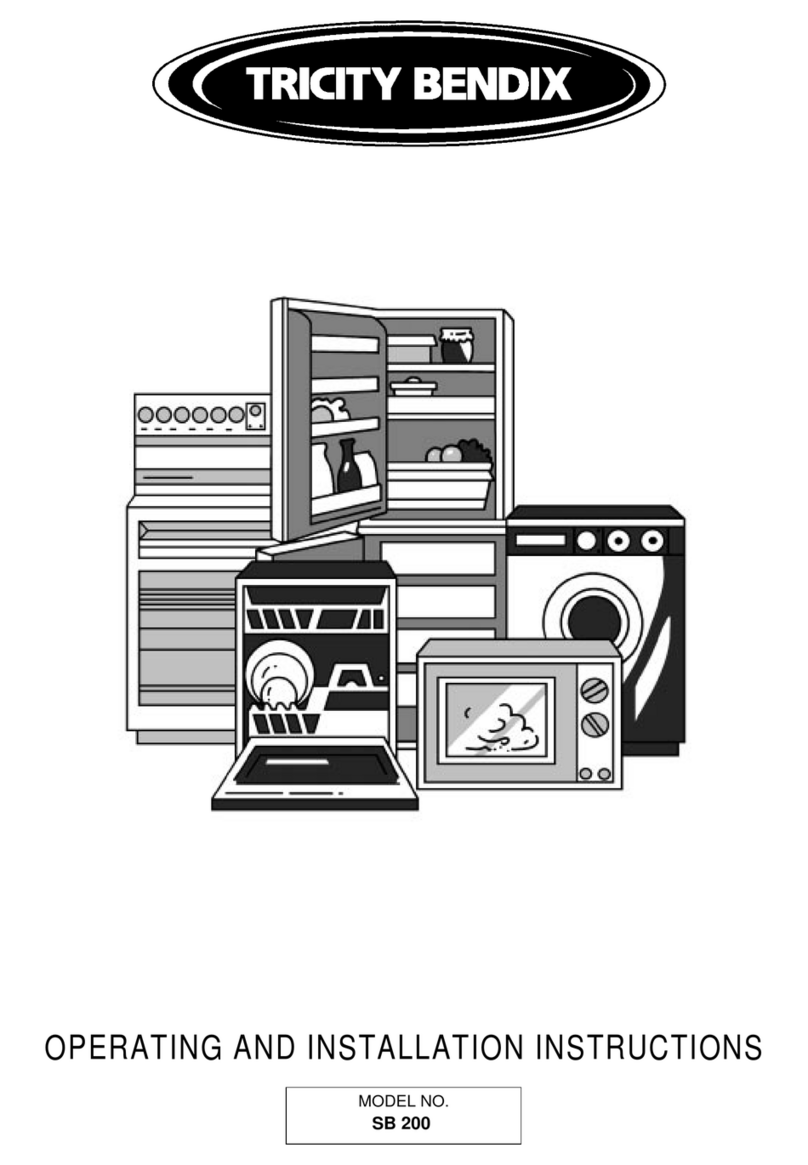
Tricity Bendix
Tricity Bendix SB 200 Operating and installation instructions
